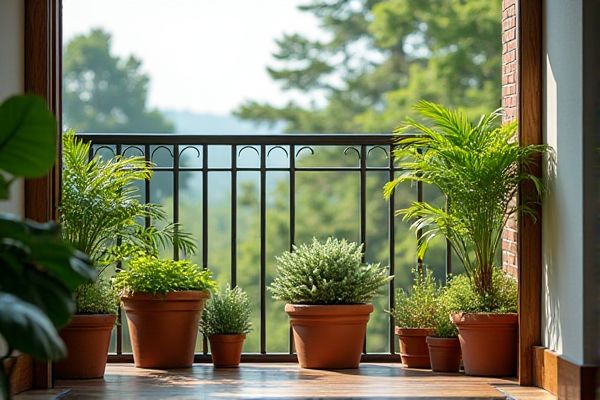
Balcony railing planters save valuable floor space and provide a charming vertical garden, while floor pots offer flexibility in placement and often accommodate larger plants with deeper root systems. Discover how each option can transform Your balcony into a green oasis by reading the rest of the article.
Table of Comparison
| Feature | Balcony Railing Planters | Floor Pots |
|---|---|---|
| Space Efficiency | Maximizes vertical space; ideal for small balconies | Requires floor space; suitable for larger balconies |
| Mobility | Fixed to railing; limited mobility | Portable; easy to move and rearrange |
| Plant Variety | Best for small plants, herbs, and flowers | Supports larger plants and small trees |
| Drainage | Dependent on planter design; may need drainage holes | Typically has better drainage; easier to manage water |
| Safety | Risk of falling if not securely fastened | Stable; less risk of tipping over |
| Installation | Requires railing attachment; moderate effort | Simple placement; minimal installation needed |
| Aesthetic Impact | Adds greenery at railing level; enhances balcony edge | Creates a garden-like feel at floor level |
Introduction: Balcony Railing Planters vs Floor Pots
Balcony railing planters maximize limited space by securely attaching to railings, offering a neat and elevated display for flowers and herbs, while enhancing safety. Floor pots provide greater flexibility in plant size and arrangement but require more floor space and can obstruct walking areas on small balconies. Choosing between railing planters and floor pots depends on balcony size, plant type, and aesthetic preferences.
Space Efficiency: Maximizing Your Balcony Area
Balcony railing planters optimize space by utilizing vertical areas without occupying valuable floor space, ideal for small balconies. Floor pots offer flexibility in placement and can accommodate larger plants but consume significant floor area, limiting movement. Choosing railing planters enhances usability by freeing up the balcony floor for furniture or other activities, maximizing overall space efficiency.
Aesthetic Appeal: Visual Impact and Design Options
Balcony railing planters offer a streamlined visual impact with their elevated placement, enhancing openness and maximizing floor space, while floor pots provide greater versatility in size and arrangement, allowing for more intricate design compositions. Railing planters often create a continuous green border that emphasizes linear aesthetics, whereas floor pots contribute to layered, dimensional looks with varied heights and shapes. Both options support diverse plant selections, but railing planters typically suit compact, trailing plants, and floor pots accommodate larger, more structural foliage.
Plant Selection: Suitability for Each Container Type
Balcony railing planters favor compact, trailing plants such as petunias, ivy, and herbs that thrive in limited soil and benefit from good drainage and airflow. Floor pots accommodate larger, deeper-rooted plants like small shrubs, dwarf trees, and perennials, providing ample space for root expansion and stability. Choosing plants based on container depth, drainage capacity, and exposure ensures optimal growth and vibrant outdoor greenery.
Installation and Setup Requirements
Balcony railing planters require secure mounting brackets or hooks to ensure stability and prevent falls, often needing drilling or clamping without damaging the railing structure. Floor pots demand flat, weight-bearing surfaces and may require protective trays or pads to avoid floor damage and facilitate drainage management. Both options benefit from choosing weather-resistant materials and proper sizing to optimize space and plant health in balcony environments.
Watering and Drainage Considerations
Balcony railing planters often require careful watering to avoid excess runoff onto the structure or below, needing well-draining soil and drainage holes that prevent water accumulation while protecting railings from water damage. Floor pots generally offer better water retention and drainage options due to their larger size, but you must ensure they have saucers or trays to catch excess water and prevent floor damage. Your choice impacts maintenance ease and plant health by balancing water control with drainage efficiency.
Maintenance: Ease of Care and Upkeep
Balcony railing planters require regular watering and trimming due to their limited soil volume, which can dry out quickly and affect plant health. Floor pots offer more soil space, reducing watering frequency and providing better root growth, leading to lower day-to-day maintenance. Both types benefit from proper drainage, but floor pots generally allow for easier soil amendments and repotting, simplifying long-term care.
Safety and Stability Factors
Balcony railing planters require secure mounting brackets and strong railings to prevent tipping or falling hazards, making their safety highly dependent on the structural integrity of the balcony. Floor pots offer greater stability due to their weight and larger base area, minimizing the risk of accidents caused by wind or movement. Choosing floor pots is advisable for high-traffic or windy balconies to enhance safety and reduce potential damage to property or people below.
Cost Comparison: Budget-Friendly Choices
Balcony railing planters generally offer a more budget-friendly option compared to floor pots due to their smaller size and efficient use of vertical space, reducing the need for additional furniture or stands. Floor pots often come with higher costs because of their larger volume, heavier materials, and the need for more soil and stability features. To maximize your budget, consider railing planters when space and cost efficiency are priorities, while floor pots may require a higher initial investment but provide greater decorative flexibility.
Conclusion: Which is Best for Your Balcony?
Balcony railing planters maximize limited space by securely attaching to railings and providing vibrant greenery without occupying floor area, ideal for small balconies or maximizing views. Floor pots offer versatility in size, mobility, and plant variety but require more balcony floor space, making them suitable for larger balconies with ample room for rearranging. Choosing between railing planters and floor pots depends on balcony size, desired plant types, and space optimization priorities.
 homyna.com
homyna.com